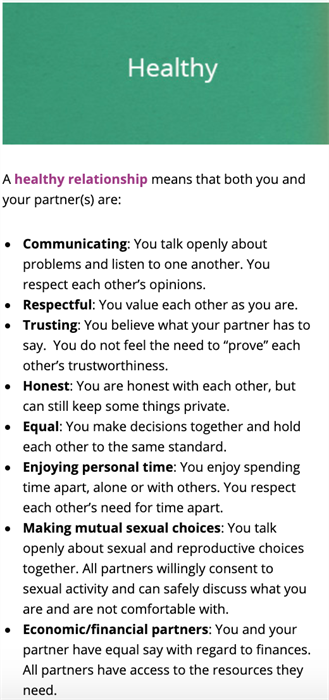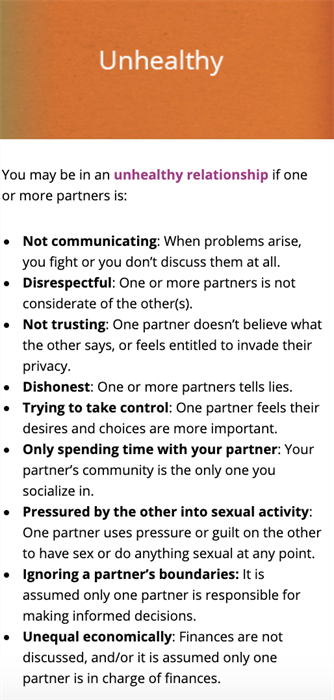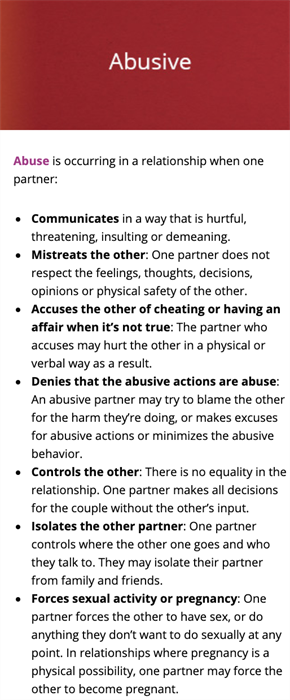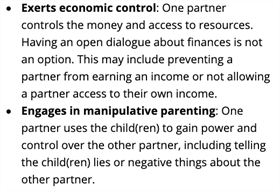WARNING!
Your online activity can be tracked! To exit this website quickly, click the button below. Computer use can be monitored, and it is impossible to completely clear your search history. If you are afraid your internet and/or computer usage might be monitored, please consider using a computer outside of your home.
Relationship Violence
We are all functions of the system that we live in; a system that has taught us how to think about ourselves and others, how to interact with others, and how to understand what is expected of us. These thought processes and expectations are based on the specific set of social identities we were born into that predispose us to unequal roles that allow us to access (or deny access) to resources.
The information here provides a basic overview of important considerations related to Relationship Violence. It is crucial that you continue expanding upon this knowledge and look further into the concepts presented that you are unfamiliar with and/or are curious about.
In addition to the resources provided below, you can also review additional terminology interconnected with Relationship Violence here.
It is important to note...
The content provided in these guides serve as a starting point for you to begin laying the foundations of your DEIA learning. We highly encourage you to reach out to the office(s)/center(s) listed within each topic to find additional resources, facilitated training opportunities, and learning tools to further your education.
Understanding Relationship Violence
Relationship violence refers to an abusive relationship where the issue of power and control is an issue. One partner feels as though they need to be solely in control of the other person and uses multiple forms of abuse to ensure that they have and maintain control in the relationship. Relationship violence is encompassed within an umbrella term called Interpersonal Violence (IPV). IPV also includes sexual violence and stalking.
The following is how the Phoenix Center at Auraria | Anschutz (PCA) defines relationship violence.
Relationship Violence: also called domestic violence, dating violence, or intimate partner violence—is a pattern of abuse that occurs in an intimate or romantic relationship. It can take many different forms, including:
- physical (e.g. hitting or pushing)
- emotional (e.g. extreme jealousy, isolation)
- verbal (e.g. yelling, swearing, name calling)
- financial (e.g. withholding money so one partner is dependent on the other)
- psychological (e.g. threats of suicide and/or homicide)
- sexual (e.g. forcing or coercing a partner to have sex when they don’t want to)
Please note, these are just a few examples of the many forms relationship violence can take.
We all live in a community where violence occurs and the community plays a part - directly or indirectly - in the fact that that it continues to occur. It is important to note that intersectionality plays a big role in how relationship violence can show up and how it is handled in our communities based on one's identity. This includes experiences, interventions, and coping mechanisms. The approach, intervention, and impact can be different depending on cultural contexts. Learn more about intersectionality within our Intersectionality learning guide.
The National Domestic Violence Hotline breaks down components of three different types of relationships using a Relationship Spectrum; "All relationships exist on a spectrum from healthy to abusive, with unhealthy somewhere in the middle." We thought it would be helpful to use their spectrum to explain components of a healthy, unhealthy, and abusive relationship.

In addition to the relationship spectrum, the PCA also has a handout with red and green flags to look out for in relationships.
What does a healthy relationship look like?
It is useful to recognize what components make a healthy relationship because everyone deserves a relationship that is healthy and free from violence.

To learn more about healthy relationships, please review the following resources:
- The Equality Circle
- Setting Boundaries in a Healthy Relationship
- Communication in a Healthy Relationship
- Trust in a Healthy Relationship
- Consent in a Healthy Relationship
- Healthy Conflict Resolution
The PCAs also have a course titled, Healthy Relationships: What’s healthy? What’s hurting? If you are interested in taking this course, fill out the Phoenix Center Workshop Request form.
What does an unhealthy relationship look like?
There are nuances in the human experience and we sometimes can act in ways that are unhealthy; acting in an unhealthy way does not vilify you and/or your partner. It just means that behaviors need to change once.

The PCAs likes to put into perspective that all abusive relationships are unhealthy, but not all unhealthy relationships are abusive.
What does an abusive relationship look like?
Abusive behavior is not always easily identifiable to outsiders or even their intimate partners. Relationship violence is a repeating cycle that often happens in three stages: the honeymoon phase, the tension phase, and the explosion phase. This is known as the Cycle of Violence. This cycle can happen across a variety of timelines, i.e. within a day, over the course of years, etc.
The cycle begins with gaining the trust of their partner through the honeymoon phase. After obtaining their trust, tension will start building as they slowly gain control of different aspects. A common characteristic of persons enacting the harm is their ability to disguise their abusive behavior to appear socially acceptable. They deny and minimize their behavior, insisting that it is their partner(s) fault utilizing tactics like gaslighting.
Eventually, this leads to the explosion phase where an incident of abuse occurs. After the explosion phase, the person enacting the harm will return to the honeymoon phase by seemingly being apologetic and remorseful. They promise to change or promise it will never happen again, and, in turn, the cycle repeats its self/continues.


The ultimate goal of a person enacting harm/abusive behavior is to use intimidation as a way to maintain power and control in a relationship.
How can learning about healthy relationships debunk problematic myths that perpetuate relationship violence?
Once patterns of abuse in relationships are identified and distinguished from healthy behaviors, it becomes easier to debunk common myths about domestic violence. These misconceptions excuse abusive behavior and reinforce toxic relationships.
Common Myths:
- Myth: Relationships are a private matter; they are not my business.
- Fact: It is your business; intervention can prevent the escalation of violence. Without intervention, children are harmed, society incurs significant costs, and abusive behaviors are perpetuated.
- BUT REMEMBER… It is important to offer support that empowers the person experiencing harm so they can take ownership in removing themselves from an unsafe situation.
- Myth: Persons who experience the harm provoke the violence and exaggerate the gravity of the abuse.
- Fact: Relationship violence needs to be taken seriously; it is a criminal act in the U.S. There is no excuse for violence. Abusive behavior is a choice; it is never the fault of the person experiencing the harm.
- Myth: Persons who experience the harm are naive to think their partner enacting the harm will change.
- Fact: While it may seem strange to you, often, the person experiencing the harm feels love for partner who is enacting the harm and may want to maintain the relationship. They want the violence to stop, not the relationship.
- Myth: It is easy for a person to end a relationship. If they don't, it's their fault.
- Fact: There are numerous reasons that prevent someone from leaving an abusive relationship; and what's more, leaving can be the most fatal moment in any relationship violence situation.
Reality of Relationship Violence:
It is common to victim blame and assume that leaving is an easy choice for someone to make. However, breaking up can be more complicated than it seems and there is a lot of privilege in assuming that everyone has the means to do so.
Here are some examples that put into perspective why leaving an abusive relationship is not always easy. Take a minute to imagine that your partner has...
- Isolated you from family and friends and you may have nowhere else to go;
- Controlled the finances so you are dependent upon them and have no financial security to afford basic physiological needs i.e. food, housing, transportation etc.;
- Threatened to hurt themselves, you, your kids, and/or your pets/property;
- Manipulated you to the point where you are unable to recognize that their relationship is abusive, feel the behavior is normal, and like you deserve it; and/or
- Threatened to “out” you if you are a member of the LGBTQ+ community and have not shared your identity with anyone else.
Additionally consider if...
- You are unable to communicate the extent of the abuse due to a language barrier;
- You are undocumented and you fear being deported if you seek help;
- You distrust authority and/or police to intervene;
- You feel obligated to stay for the safety of yourself or your kids;
- You fear that if you leave and the violence will intensify; and/or
- You are physically dependent on your partner because of a disability* and leaving would cause significant consequences to your health/well-being.
Like we said, when you think about all of these extenuating factors, of which there are many more, walking out the door is not as easy as it seems.
What we need to recognize as a community is that relationship violence IS our business; it is not a private matter and appropriate intervention (that empowers and honors the choices of the person who is experiencing the harm) in a situation can prevent the escalation of violence.
If you are in an abusive relationship, we encourage you to reach out to a confidential resource to talk about your experience and develop a safety plan should you decide to leave an abusive relationship. If you know someone who is experiencing abuse, one of the most important things you can do is be there for them and offer support without judgment. Let them know that they deserve respect, and that the abuse is NOT their fault.
Note*: Learn more about being in an abusive relationship when you are physically dependent on the person enacting the harm using the Power and Control Wheel: People with Disabilities and Their Caregivers.
Content and resources were adapted from: the Phoenix Center at Auraria and the Phoenix Center at Anschutz (PCAs), The National Domestic Violence Hotline, Arizona Coalition to End Sexual & Domestic Violence, and CSU's Women and Gender Advocacy Center.
What causes abusive behavior?
Just like any other behavior, abusive behavior is learned. Persons who enact harm do so for power and control; to manipulate and intimidate their intimate partners. Persons who enact harm believe they are entitled to rule in the partnership; maybe because they think they know best or because they experienced similar behavior growing up i.e. this person saw a dominant figure in their family rule with verbal, emotional or physical abuse.
However, no matter where or how abusive behavior is learned, it is never justifiable. Abuse is a choice that intimate partners are often manipulated to take responsibility for. There are many people who experience or witness abusive behavior growing up and choose not to abuse their partner(s). Persons who enact harm are always responsible for their behavior.
What tactics do persons who enact harm use to maintain power and control?
When most people think of an abusive relationship, they think of someone being physically assaulted; however, there are many forms of abusive behavior that one can inflict on their intimate partner. Persons who enact harm often believe that their own feelings and needs should be the priority in their relationships, so they use abusive tactics (not always physical) to dismantle equality and make their partners feel less valuable and deserving of respect in the relationship.
To help explain the different tactics an abusive partner can use to keep their victim in a relationship, the Power and Control Wheel was created. This wheel describes the following as forms of abuse (listed in no particular order):
- Physical
- Sexual
- Psychological
- Financial
- Emotional
- Pets & Property
- Intellectual
- Using Children
- Social
- Verbal
- Using Culture
- Spiritual
Why is relationship violence not always talked about in a gender-neutral way?
The data available suggests that this crime is committed predominantly by cisgender men, however, this does not mean that violence does not happen in LGBTQ+relationships or is not enacted against cisgender, heterosexual men by cisgender, heterosexual women. Due to the data available, relationship violence is often mistakenly discussed as a women’s issue.
Learn more about persons in the LGBTQ+ community within our Gender Visibility learning guide.
Relationship violence can show up in different ways because abuse takes many forms. This is one example of what this can look like.
What Can I Do?
If you are seeking support because you have or are currently experiencing relationship violence, and/or if your friend or loved one is experiencing relationship violence, there are options for you.
The PCA also has a helpful handout for supporting survivors who are disclosing to you.
IF YOU ARE IN DANGER...
We encourage you to call 911. You can also contact police on-campus. The Auraria Police can be reached at at 303.556.5000 and the Anschutz Police can be reached at 303.724.4444.
IF YOU NEED SUPPORT OR ASSISTANCE...
Call the PCA's free and confidential, 24/7 crisis helpline at 303-556-CALL (2255).
Resources
Disclaimer
In an effort to assist the University community and the general public, the OE has gathered the list of resources above, including links to websites. Please note, the OE does not accept solicitations to partner, sponsor, promote, and/or publish content from external organizations.
Disclaimer terms regarding published materials:
- The OE is not responsible for the accuracy, legality, or content of the resources above.
- The OE does not endorse any particular resource, product, service, institution, or opinion expressed in the resources, nor does the OE necessarily endorse views expressed or facts presented by the providers or institutions.
- The OE and its employees do not make any warranty, expressed or implied, nor assume any liability for the services provided by any entity, program or resource identified on this site or through links from this site. Further, the OE does not provide any funding to the organizations, programs, and resources identified herein and/or through links. The OE does not provide dedicated funding for these resources.
Acknowledgement
Diversity, equity, inclusion, and access (DEIA) work represents a historical function and is a practicing science. We ask that any redistribution or reproduction of content is credited appropriately to the creators of the content, and if applicable, credited to any scholars or outside resources that were acknowledged and cited in adapted content.
Credit: Sara D. Anderson, Karissa Stolen, and Paulina Venzor, 2020, Office of Equity at the University of Colorado Denver and University of Colorado Anschutz Medical Campus